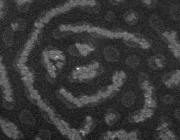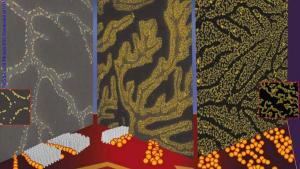Citation:
Date Published:
MAY 1Abstract:
Tetraanions of alkyl-substituted derivatives of cycloocta[1,2,3,4-def,5,6,7,8-d'e'f']bisbiphenylene (BPD) and their counter lithium cations self-assemble to form helically stacked assemblies, including a dimer, a trimer, and a tetramer. NMR self-diffusion measurements and unprecedented magnetic shielding effects for the sandwiched lithium cations support their aggregated nature. The D2-tetramer assembly is fully characterized by NMR spectroscopy, providing unequivocal evidence for a helix of four tetraanionic BPD layers with an estimated relative twist angle of about 45degrees and interlayer spacing of ca. 4 Angstrom. The barrier for racemization through the in-plane inter-deck rotation is DG200(double dagger) = 9.5 +/- 0.2 kcal mol-1 in the dimer compared to >15 kcal mol-1 in the tetramer.






